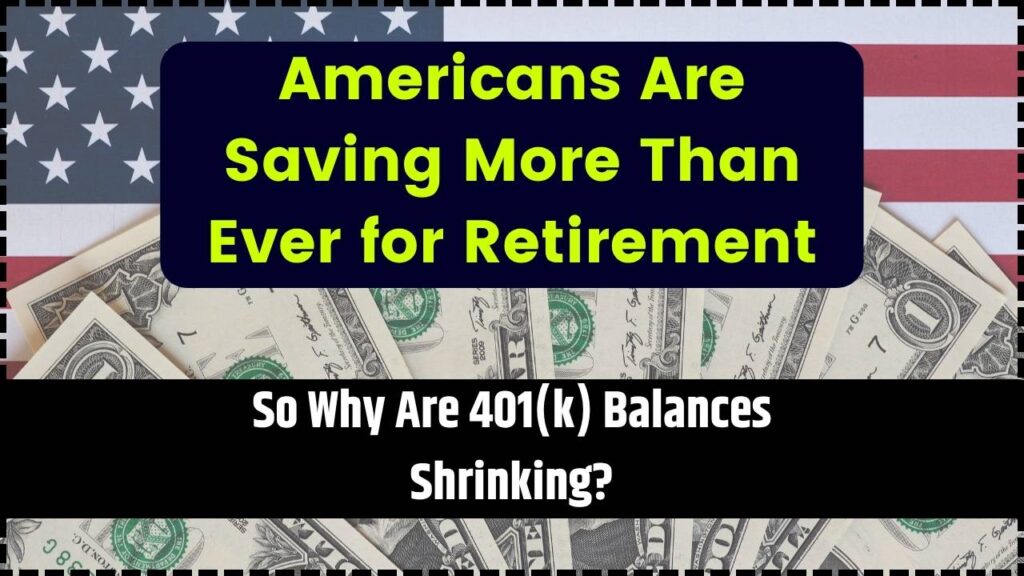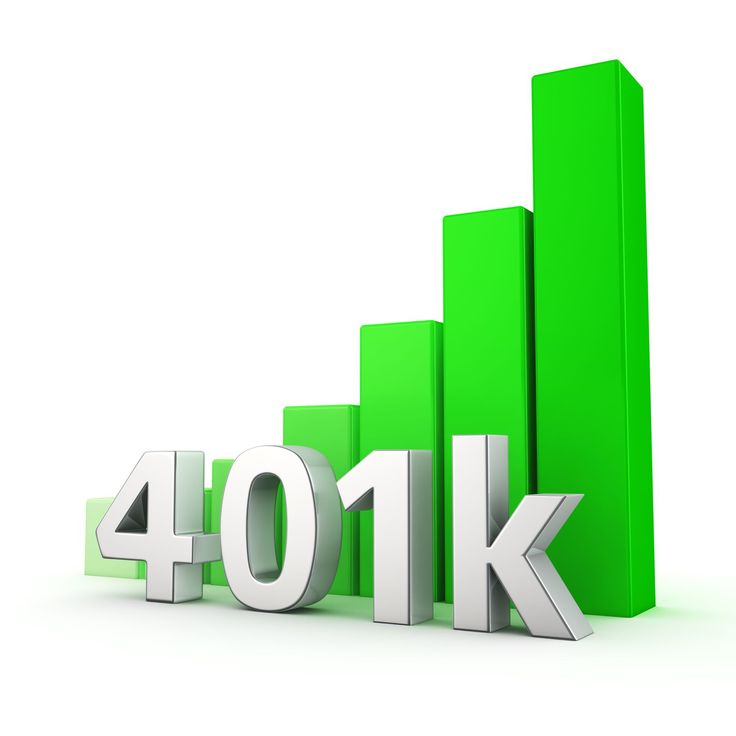
Americans Are Saving More Than Ever for Retirement: In 2025, Americans are saving more for retirement than at any point in history. According to Fidelity, the average 401(k) contribution rate—combining employee and employer contributions—has hit a record-high 14.3%. On the surface, that seems like reason to celebrate. But there’s a twist: many workers are looking at their 401(k) accounts and noticing the balances are shrinking. This apparent contradiction has left savers confused. How can you be saving more and still be falling behind? In this in-depth article, we’ll break down why this is happening, what factors are influencing your retirement account balances, and—most importantly—what you can do to protect your financial future.
Americans Are Saving More Than Ever for Retirement
Saving for retirement isn’t just about setting aside money—it’s about making sure that money is working hard for you. While Americans are saving more than ever, shrinking 401(k) balances show that market behavior, inflation, poor investment allocation, and early withdrawals are all powerful forces at play. By understanding these trends, reviewing your investments, staying calm in volatile times, and diversifying your savings strategies, you can position yourself for long-term success—no matter what the headlines say. Keep saving smart, stay informed, and remember: the best time to act for your future is always right now.
| Topic | Details |
|---|---|
| 401(k) Contribution Rates | Reached an all-time high of 14.3% in 2025 |
| Market Impact | S&P 500 dropped 4.3% in Q1 2025, impacting retirement investments |
| Loan/Withdrawal Activity | 18.8% of 401(k) holders have taken loans or early withdrawals |
| Average Balance | Average 401(k) balance: $112,400, down from $117,000 in late 2024 |
| Official Guidance | IRS 401(k) Plan Resource Guide |
Americans Are Saving More Than Ever for Retirement — That’s the Good News
There’s no doubt that Americans are listening to the message of saving for retirement. The median contribution rate for workers in 2025, combining personal contributions and employer matches, is about 14.3% of income. Financial advisors generally recommend saving between 15% to 20% of your annual income, so this is a strong trend in the right direction.
Auto-enrollment and employer-matching policies are partially responsible. Many companies automatically enroll new employees at 3% to 6% and boost the percentage annually. This nudge has led more Americans to prioritize their retirement plans, even if they don’t think about it daily.

So Why Are 401(k) Balances Shrinking?
Despite all this positive saving behavior, many account holders are seeing their 401(k) balances go down. This isn’t necessarily a sign of failure—rather, it reflects several complex factors working in tandem.
Market Volatility
The first and most obvious reason is market performance. In early 2025, the stock market took a dip. The S&P 500 dropped 4.3% in the first quarter. Given that many retirement plans are heavily invested in equities, any downturn in the market directly affects account balances.
Even target-date retirement funds, which are designed to adjust risk based on your expected retirement year, still maintain significant stock exposure. When the market drops, so does your portfolio value—even if you’re contributing regularly.
Inflation and Real Value Loss
Another key factor is inflation. Even if your 401(k) grows by 5% annually, if inflation is 6%, your purchasing power is effectively going down. In recent years, inflation has hovered around 3–6%, depending on the sector. For retirees or near-retirees, this erodes the true value of their savings.
What used to cover 20 years of retirement now might only stretch 17 or 18 years. That subtle but powerful change has long-term consequences for financial planning.
Increased 401(k) Borrowing and Early Withdrawals
In 2025, nearly 19% of 401(k) participants have either taken a loan or early withdrawal, according to MarketWatch. With rising housing, healthcare, and education costs, many people are tapping into retirement accounts to meet immediate needs.
While these tools offer financial relief, they also reduce long-term compounding. A $10,000 withdrawal at age 35 can mean giving up more than $75,000 in future value, assuming a 7% annual return over 30 years.
Conservative Default Investments
Many retirement plans automatically place new contributions in “stable value funds” or money market accounts. These are designed to avoid risk, but they also offer very little return—often 1% to 3%. That means you could be contributing more without seeing growth, especially in inflationary environments.
If participants never log in and reallocate their investments, they could be missing out on market gains.
A Look at the Bigger Picture
Historically, 401(k) plans have performed well over the long term. According to Vanguard, someone who consistently contributes to their retirement account and maintains a diversified portfolio can expect average annual returns of 6% to 8% over a 30-year span.
But that return assumes steady markets and disciplined investing. When investors panic during downturns and move to cash or stop contributing, the long-term benefits are compromised.
What You Can Do About It
You can’t control the stock market or inflation. But you can take actionable steps to improve your 401(k) performance.
1. Review and Adjust Your Investment Allocation
Log into your retirement portal and review your investment choices. Are you overly conservative? Too aggressive? Consider:
- Target-date retirement funds
- Index funds tracking the S&P 500
- Bond/equity blends based on your age and risk tolerance
If you’re not sure how to balance your portfolio, use free tools like:
2. Increase Your Contributions When Possible
Even a small increase—1% more per paycheck—can have a huge impact over time. In 2025, the IRS contribution limits are:
- $23,000 for workers under age 50
- $30,500 for workers 50 and over (includes catch-up contributions)
Check with your HR department or plan provider to change your contribution percentage.
3. Avoid Emotional Reactions
When the market is down, it’s tempting to stop contributions or move your money to cash. This “panic selling” locks in losses and prevents you from benefiting when the market rebounds.
Remember, the average bear market lasts 9 to 14 months, while the average bull market runs 3 to 5 years. History favors patience.
4. Use Multiple Retirement Vehicles
While 401(k)s are great, they’re not your only option. Consider also using:
- Roth IRA: Post-tax contributions, tax-free withdrawals
- Traditional IRA: Pre-tax contributions, tax-deferred growth
- HSA (Health Savings Account): Triple-tax advantages for medical and retirement use
- Taxable brokerage accounts: Greater flexibility and no early withdrawal penalties
5. Build an Emergency Fund
Many 401(k) loans or early withdrawals happen because people don’t have accessible emergency savings. Aim to keep at least 3 to 6 months of living expenses in a separate high-yield savings account.
Real-Life Story: How One Saver Turned It Around
Emily, 42, works in IT and had been diligently saving 10% into her 401(k). In early 2025, she noticed her balance had dropped by $9,000. She was frustrated but didn’t panic. After speaking with her plan advisor, she discovered she was 100% invested in a stable value fund—earning only 2%.
She switched 70% of her balance into a diversified stock and bond mix. By mid-year, her balance rebounded and she increased her contribution to 12%. Emily’s story highlights how active management and strategy adjustments can yield better results.
Your 401(k) Might Be Down; But New Data Shows Savers Aren’t Backing Off
Your 401(k) Crypto Dreams May Be Over — Here’s Why the Labor Department Pulled the Plug
2026 Retirement Payment Could Rise — Check How Much Your Check May Increase!











